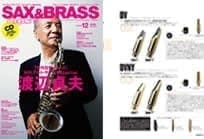What Is the DV Soprano Saxophone Mouthpiece?
Jody Espina has introduced the concept of Golden Section Proportions to the art of high end saxophone mouthpiece design. This perfect chamber/bore/facing combination will result in an extraordinary playing experience for you.
Three Goals in Creating the DV Series of Saxophone Mouthpieces
- To create the most efficient sax mouthpiece possible. That means that there are more harmonics present in the sound and therefore the projection of this Soprano sax mouthpiece is huge.
- To eliminate the annoying shrillness that is associated with loud bright soprano saxophone mouthpieces.
- To have a big fat midrange and bottom end that has never been present before in a soprano sax mouthpiece with strong projection.
Effortless Power & Beauty
Here, nature, science and imagination combine to create a revolutionary new saxophone mouthpiece. Jody Espina has designed the JodyJazz DV (U.S. Patent No. 7,470,844) using proportions and principles found in nature. For the most effortless playing experience of your life we invite you to try the DV.
JODYJAZZ ARTIST TESTIMONIALS

“Having grown up playing JodyJazz mouthpieces, I consider my DV Alto 7 an integral part of my sound and brand. I can’t imagine ever switching to another mouthpiece, they just can’t compete!”

“My SUPER JET mouthpiece is killing! I’m really in love with it. I had never played a mouthpiece like this one, it is very easy to play all over the register. Finally, I’ve found my sound: The SUPER JET.”

“Jody, This mouthpiece is so complete. It’s perfect just the way it is. I love the thick heavy sound it gets. I can’t wait to play it in the Duke Ellington Orchestra tonight.”
MAGAZINE REVIEWS
June Issue

JazzTimes Magazine - 2008
"In general, my saxophone mouthpieces are like airport security: metal is usually not encouraged. It’s not that I dislike the sound of metal. In fact, I do like it, especially in contemporary settings. It’s just that
metal mouthpieces come at a cost—more on that later. Yet if anyone is capable of changing my view, it’s Jody Espina (a.k.a. JodyJazz). I have had the pleasure of playing and reviewing a number of JodyJazz
mouthpieces, including the inaugural offering from the DV and DVNY lines (both tenor mouthpieces). So reviewing two “siblings” (a DVNY alto mouthpiece and a DV baritone model) was not so much about testing the abilities of the design, but rather transposing the idea to other saxophones..."
May Issue

DownBeat Magazine - 2008
"JodyJazz continues to produce new models of gold-plated brass mouthpieces that give serious saxophone players further options for great sound and response. The JodyJazz DV NY alto #5 and DV baritone #8, released early this year, bring metal professional sax mouthpieces to new levels of efficiency and tonal flexibility."
June Issue

DownBeat Magazine - 2007
"Neumann has introduced its KMS 104 hand-held wired microphone for live performance applications, a follow-up to the company’s KMS 105 model. Designed for optimal transmission of the
human voice on loud stages, the KMS 104 improves on the KMS 105 with the added feature of a cardioid polar pattern. Neumann’s entire KMS series offers higher acoustic transparency than most
other handhelds, allowing a wider frequency range with better resolution of audio transients..."
February Issue

DownBeat Magazine - 2006
"Two new sets of precision crafted mouthpieces from JodyJazz give saxophonists the airflow and the versatility that they need to cover a wide range of tones and styles..."
" … produced a warm, dark tone and blew freely and evenly across the traditional range of the horn. … Extremely responsive, the HR* lets you tongue fast and accurately through uptempo passages without choking up in the throat. "
"... the most inspiring were the DV alto mouthpieces. Bright, full of harmonics and brassy without being shrill, the DV altos projected effortlessly in all ranges, with an especially wailing altissimo. It was easy to play quiet and low with a fat, full sound. Intonation was spot-on."
JodyJazz Soprano Sax DV Mouthpiece Price: $595
The mouthpiece comes with a Rovner Ligature & Cap, Deluxe Mouthpiece Pouch and special Wood Cylinder case. Free domestic US Priority Mail shipping and handling included. (Click “Buy Now” button to see overseas shipping)
$595.00
JodyJazz DV Soprano Saxophone Mouthpiece Demonstration by Jody Espina
Andy Snitzer Plays DV Soprano Sax Mouthpiece
Ed Calle Plays DV Soprano Sax Mouthpiece. Performing a semi-classical piece with Negroni.
As Seen on Full Page Advertisements

JodyJazz Soprano Sax DV Mouthpiece Available Tip Openings
- 6* = .065
- 7* = .075
- 8* = .085
- 9 = .090
- 10 = .100
Do you need a facing comparison chart?
CLICK HERE to compare JodyJazz mouthpieces with other brands.
“Dream Come True”
The new facing curve results in absolutely no dead spots in the vibration of the reed. In other words all notes in all ranges respond equally. This Metal Soprano sax mouthpiece has a warm tone while being able to sing and soar over the top of any band. Sub toning and low notes are extremely easy and Intonation is spot on. To my knowledge, there is no other soprano saxophone mouthpiece that blows like the DV. Most soprano sax mouthpieces have back pressure when play them but the DV soprano will let you play it like your alto or tenor. Be prepared to have possibly the most fun you ever have had on the saxophone.
Players who now or in the past have played Guardala, Dukoff, Beechler, Jumbo Java, SR Tech, Vandoren V16, Yanigisawa, or any of the bright mouthpieces out there will be sure to love The DV. This is not just another bright mouthpiece. There will be noticeable differences and improvements.
I have found that many straight ahead jazz players who tend to favor mouthpieces that are just a little brighter than most mainstream dark mouthpieces have a very high chance of making the DV their new Soprano sax mouthpiece. We have had many many converts who came from playing the most popular hard rubber Jazz piece. These players almost always think that they won’t like a metal Soprano mouthpiece and they are surprised everytime.
All saxophone players are amazed to find a saxophone mouthpiece that works so efficiently, where the articulation is clean and one can easily go from low to high and vice versa.
The DV is manufactured on the most sophisticated computer controlled Lathes and Mills, yet the DV benefits from a high degree of hand finishing. The attention to detail in design and finishing given to the DV results in a stunning work of art that plays like a dream come true.
What Does The DV Do?
- Bigger Fatter Tone
- Effortless Playing
- More Harmonics
- Cleaner Articulation
- Power and Projection
- Unbelievable Altissimo
- Improved Intonation
How Does The DV Do It?
- Secondary window
- Golden section proportioning
- Proprietary CNC facing technology
- Perfect radius facing curve
- Perfect reed/Tip match
- 24 kt heavy gold plating
- Hand finished baffle, tip rail and table
- Play tested by Jody Espina
DV Difference
- Phi Proportions – Or the Golden Section Proportioning. The proportions that are found in the Stradivarius Violin, the Nautilus shell, the dolphin, human beings, the Ancient Pyramids and much more, are used for the first time on a saxophone mouthpiece. These proportions result in a chamber that increases harmonics making the sound bigger and richer. For more information about Phi visit at http://www.goldennumber.net

- Secondary Window – The moving sound wave inside of the mouthpiece is now able to strike the vibrating reed above the bore of the mouthpiece instead of the mouthpiece material that is usually there. The effect is similar to a moving ball striking a moving bat. Home Run!

- New Facing Technology and Curve – We have invested in new CNC technology and have come up with a proprietary way of putting on a new facing curve, which is perfect every time.
Special Notes on The DV Soprano Saxophone Mouthpiece
Due to the free blowing nature because of the facing curve of the DV soprano and all the DV’s , be prepared to use a harder reed than you normally do. This may or may not be the case for you. The great benefit of this is that a harder reed lasts longer. A harder reed also helps the altissimo range.
For this same reason, you may want to try a slightly more open tip than normal.
Tuning: When you first try the DV Soprano I recommend that you push the mouthpiece on the neck until you see a little bit of the neck peeking through the secondary window. This may or may not be the correct position for you but I want to make sure that you start playing near where the mouthpiece will probably go on the neck.

Almost all metal mouthpieces in the past and at the present time are made out of brass which can contain up to 3% lead. The lead in the brass is one of the components that give this particular brass it ’s hardness or rather it’s softness which makes it have a particularly pleasing sound to musicians. Proposition 65 from the state of California requires manufactures to label any products that have compounds in them that have been found to cause Cancer or Reproductive Harm. Lead is one of these Compounds. JodyJazz mouthpieces are electroplated with a layer of copper, then a layer of Nickel, Silver or Rhodium, and then a layer of Gold or Silver. This electroplating ensures that the raw brass is never in contact with the player.
This is Jody Espina and yes myself and my employees have been using JodyJazz Gold or Silver Plated brass mouthpieces for many years. My first JodyJazz brass mouthpiece was made in 2001 and I have continuously been playing JodyJazz brass mouthpieces since. I played my first metal mouthpiece in 1979 on tenor sax and have always used a brass mouthpiece on tenor sax ever since then.
Yes. Ben Webster, Coleman Hawkins Stan Getz, Sonny Rollins, Dexter Gordon, John Coltrane, Michael Brecker, Tom Scott Andy Snitzer are just a few of the 1000’s and 1000’s of players who have played brass mouthpieces.





